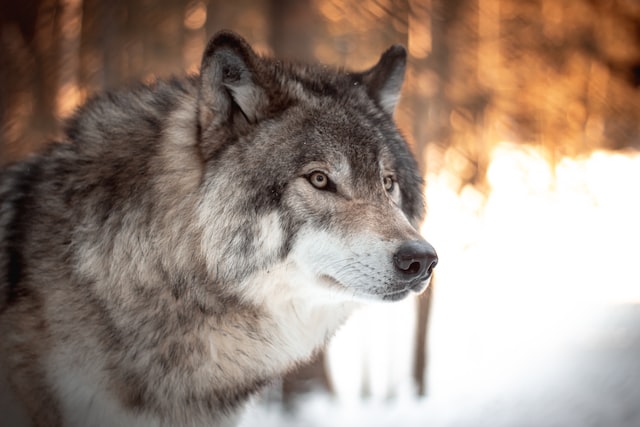Foxes and wolves are both members of the Canidae family, but there are some key differences between them. Foxes are smaller and more solitary than wolves, with a narrower snout and smaller ears, while wolves are larger, more social, and have a broader snout and larger ears.
What is a Fox?
(Photo by Ray Hennessy on Unsplash )

A fox is a small-to-medium-sized mammal belonging to the Canidae family, which includes other canines such as wolves, coyotes, and domestic dogs. Foxes are known for their bushy tails, pointed snouts, and playful, curious behavior. There are several species of fox found around the world, including the red fox, gray fox, and arctic fox.
What is a wolf?
(Photo by Milo Weiler on Unsplash )

A wolf is a large, carnivorous mammal belonging to the Canidae family, which includes other canines such as foxes, coyotes, and domestic dogs. Wolves are known for their distinctive howl and pack behavior, and are found in a variety of habitats throughout the world, including forests, grasslands, and tundras. There are several subspecies of wolf, including the gray wolf, red wolf, and arctic wolf.
The physical differences between foxes and wolves
Foxes and wolves have several physical differences that set them apart from each other:
Size: Wolves are generally larger than foxes, with the average adult wolf weighing around 60-120 pounds, while adult foxes typically weigh between 5-30 pounds.
Shape: Foxes have a slender body shape, with long, narrow snouts and small, pointed ears. Wolves, on the other hand, have a more robust body shape, with a broader snout and larger ears.
Fur color: Foxes are typically red, gray, or brown, with white underparts, while wolves are usually gray or brown with black markings.
Tail: Foxes have long, bushy tails that they use for balance and communication, while wolves have shorter, bushy tails that they use for communication.
Behavior: Foxes are typically solitary animals, while wolves are social animals that live in packs. Wolves also have a distinctive howl, while foxes have a range of vocalizations including barks, whines, and screams.
Foxes and wolves have several physical differences that make them easily distinguishable from each other, as well as differences in behavior and habitat.
The habitat differences between foxes and wolves
There are several key habitat differences between foxes and wolves. Foxes tend to live in more rural areas with lots of underbrush and trees, while wolves prefer more open spaces like forests or tundras. This likely has to do with the different prey each species typically goes after – foxes hunt smaller game like rodents or birds, while wolves go after larger prey like deer or moose. Another difference is that foxes dens are usually only used by a single family, while wolf dens are often shared by multiple families or even an entire pack. Finally, foxes will sometimes cache (or hoard) their food, hiding it away for later, while wolves will eat everything they kill right away.
The diet differences between foxes and wolves
Foxes and wolves are two very different animals, and their diets are a big part of what makes them so different. Foxes are much smaller than wolves, and they have a very different digestive system. This means that they can’t eat as much meat as wolves can, and they need to eat more plant-based food.
Foxes also have a higher metabolism than wolves, which means that they need to eat more often. A fox’s diet is mostly made up of small mammals like mice and rabbits, as well as insects, berries, and other fruits and vegetables. Wolves, on the other hand, are able to digest larger prey, so their diet consists mostly of deer, elk, and other large mammals.
While both foxes and wolves are carnivores, the difference in their diets is a big part of what makes them such different animals.
How to tell a fox from a wolf
As you might expect, foxes and wolves are different animals. They belong to different species, have different appearances, and behave differently. Here are some tips to help you tell them apart:
- Foxes have pointy faces, while wolves have more rounded faces.
- Foxes have smaller, sharper teeth than wolves.
- Foxes have shorter legs than wolves.
- Wolves are usually larger than foxes.
- Foxes can be a range of colors, including red, orange, silver, and white. Wolves are typically gray or brown.
- Foxes typically live in forests and woods, while wolves live in more open areas like fields or mountains.
Can fox’s and wolfs be kept as pets?
Foxes and wolves are not recommended to be kept as pets, as they are wild animals and have specific needs and behaviors that can be difficult to meet in a domestic setting.
Wolves, in particular, are large, powerful animals that require a great deal of space, exercise, and specialized care. They are also social animals that live in packs, and it can be difficult to replicate this environment in a domestic setting. In some countries, it is also illegal to keep wolves as pets.
Foxes, on the other hand, are smaller and more adaptable than wolves, but they are still wild animals and can be difficult to keep as pets. Foxes require a large amount of space to run and play, as well as a specialized diet that may be difficult to provide in a domestic setting. Additionally, some species of fox are illegal to keep as pets in certain regions.
In addition to the challenges of meeting their physical needs, foxes and wolves are also wild animals with natural instincts that can be difficult to suppress in a domestic setting. They may exhibit destructive behaviors, such as digging or chewing, and can pose a danger to humans and other pets.
It is not recommended to keep foxes or wolves as pets, as they are wild animals that require specialized care and can be dangerous to humans and other pets. It is important to respect these animals’ natural habitats and allow them to live freely in the wild.
Is a Husky a wolf?
A husky is a type of wolf, but there are some key differences between the two. For one, huskies are usually much smaller than wolves. They also have different coat colors and patterns, and they typically have blue or green eyes (wolves usually have brown eyes). Additionally, huskies are known for being friendly and good with people, while wolves are often more wary and aggressive around humans.
What are the different species of fox?
The word fox can refer to many different species of canid, or dog-like carnivore, including the Red Fox (Vulpes vulpes), Gray Fox (Urocyon cinereoargenteus), and the Arctic Fox (Vulpes lagopus). These are just a few of the over 30 species of foxes that exist in the world today.
While all foxes share certain similarities, such as their pointed ears and sleek fur coats, there are also many differences between them. For example, Red Foxes are the largest species of fox, while Arctic Foxes are the smallest. Additionally, Gray Foxes are unique in that they are the only species of fox that can climb trees.
What are the different species of wolf?
There are four different species of wolf that are found in North America: The Gray Wolf, The Red Wolf, The Eastern Wolf, and The Arctic Wolf.
The Gray Wolf is the most common species of wolf, and is found throughout the continental United States and Canada. The Red Wolf is found in the southeastern United States, while the Eastern Wolf is found in eastern Canada. The Arctic Wolf is found in northern Canada and Alaska.
Who are the foxes greatest predators?
The fox’s greatest predators are humans, coyotes, and eagles. Humans hunt foxes for their fur, which is used to make clothing and other items. Coyotes typically hunt foxes for food, although they will also kill them to protect their territory. Eagles typically prey on young or sick foxes, but have been known to kill healthy adults as well.
Featured Image By – Photo by Dušan veverkolog on Unsplash








